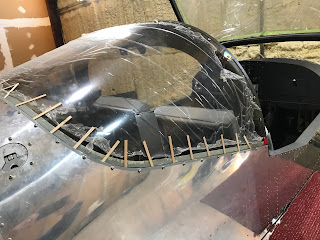The spinner comes as a fiberglass cone with no cutouts for the prop blades and a bit too long. The first task is to trim the length and cut out the slots for the blades. A previously discussed bushing for the Pitot must be glued into the tip.
After all the fiberglass cutting I've done for the project I've reached the conclusion that nothing beats a Dremel tool with a fiber cutting wheel. With all the cutting for the cowling (coming soon to a browser near you) I bought Dremel's knockoff of a Fein tool (vibrating blade rather than rotating or translating), thinking it might put less dust in the air (and in my lungs -- I think facial hair prevents a good seal with the dust mask). The Fein tool was overkill. If there were a smaller, battery-operated version of this tool it might be perfect.
After that trimming, the spinner was trial fit as shown, being careful that the prop cutouts allow the inside of the spinner to press firmly against the forward and aft bulkheads. It was immediately obvious that the original cuts to the scribe lines were not enough. Clamps held the spinner in this position for drilling. As received, there are pilot holes in the front bulkhead for the nut plate center holes to be drilled in the spinner.
At this point I checked the runout in the Pitot tube referenced to the sharpened nail pressed into the stationary board shown. The point was centered immediately in front of the Pitot and the prop was rotated 360 degrees while checking for movement of the Pitot. I did this with considerable trepidation, not knowing how I would fix it if the runout were unacceptable (>1/16th inch). I could see no movement.
The center holes for the nut plates attached to the aft bulkhead were drilled using the drill guide that I cobbled together (shown below). The lower plate rests against the aft edge of the bulk head flange, the middle plate is a spacer for the fiberglass, and the upper plate has the guide hole for the drill. I made these out of scrap 4130 and held the sandwich together with vice grips. This assured that all the holes were drilled in the correct axial location. The aft edge of the spinner fiberglass extends a bit beyond the aft edge of the bulkhead flange and will be sanded flush once the nut plates are installed and the spinner is attached.
The holes for the solid rivets which secure the nut plates to the aft bulkhead required use of my TiteFit drill kit (shown below). As I've said before, there are quite a few holes I couldn't have drilled without this thing.
The nut plates are held in place temporarily with a #8 screw while the #40 holes are drilled and attached with solid, counter-sunk rivets.
The final step is to construct the "gap fillers" which go behind the prop roots, ostensibly reducing drag. These are made from the fiberglass pieces cut out in the first step. I didn't realize this so I didn't make any attempt to make the cut with the Dremel tool as thin as possible. This lack of reading ahead caused me to end up with a much wider gap than I'd like. I'll probably fill it with micro later.
I hate setting solid flush rivets in fiberglass. The countersink has to be made with the rivet head sitting a little proud of the fiberglass surface before setting. Otherwise you'll crush the fiberglass a bit. (Side note: When a part which should be flush with a surface instead protrudes a bit above the surface it is said to be a bit proud of the surface. I'm trying to introduce a new term to the lexicon of aircraft fabrication: If a part which should be flush ends up a bit under the mating surface, it will henceforth be described as being a bit ashamed of the surface).
There's definitely an art to getting solid rivets squeezed perfectly, even in metal. With several of the solid rivets attaching the gap fillers to the flange I had the opportunity to exercise my considerable skill at drilling out solid rivets and re-doing them. This hard-won skill is a testament to the number of times I've screwed up a rivet.
Off topic: Another one of my new Colorado neighbors.



























